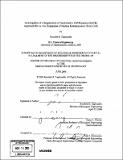| dc.contributor.advisor | James L. Sherley. | en_US |
| dc.contributor.author | Taghizadeh, Rouzbeh R | en_US |
| dc.contributor.other | Massachusetts Institute of Technology. Biological Engineering Division. | en_US |
| dc.date.accessioned | 2007-08-03T18:18:39Z | |
| dc.date.available | 2007-08-03T18:18:39Z | |
| dc.date.copyright | 2006 | en_US |
| dc.date.issued | 2006 | en_US |
| dc.identifier.uri | http://hdl.handle.net/1721.1/38243 | |
| dc.description | Thesis (Ph. D.)--Massachusetts Institute of Technology, Biological Engineering Division, 2006. | en_US |
| dc.description | Includes bibliographical references. | en_US |
| dc.description.abstract | Ex vivo expansion of hematopoietic stem cells (HSCs) is a long-standing challenge faced by both researchers and clinicians. To date, no robust, efficient method for the pure, ex vivo expansion of human HSCs has been demonstrated. Previous methods primarily induced the expansion of committed hematopoietic progenitor cells (HPCs), yielding even less pure populations of HSCs. This research was based on the hypothesis that, like for other adult stem cells (ASCs), the major barrier to expanding HSCs ex vivo is in preferentially regulating the asymmetric self-renewal of HSCs without loss in their ability to produce differentiated committed HPCs. This laboratory has shown that a p53-dependent pathway specifically controls the self-renewal pattern of several types of ASCs and thereby provides an effective means for expansion of ASCs in culture. The method, which involves the use of purine metabolites to achieve suppression of asymmetric cell kinetics, is referred to as SACK. The utility of the p53-dependent pathway was investigated for directing expansion of human HSCs. In order to support this investigation, the proliferation of HPCs in in vitro cultures was repressed by culturing cells without hematopoietic growth factors and cytokines. | en_US |
| dc.description.abstract | (cont.) This allowed the in vitro detection of SACK-effects on a small sub-population of cells, predicted to include HSCs. In order to determine the self-renewal capacity and multilineage potential of SACK- cultured cells, they were transplanted into non-obese diabetic/severe combined immunodeficient (NOD/SCID) mice. In vivo transplantation investigations exhibited 1.9- fold to 4.5-fold increased engraftment efficiency with SACK-agents compared to SACK-free controls, suitable for clinical applications. This result suggests that SACK-culture expands a population of SCID-repopulating cells (SRCs) that yields self-renewal and multilineage engraftment in NOD/SCID mice. Accordingly, increased engraftment efficiency for successful clinical applications may be achieved after additional optimization of HSC expansion. To obtain the full therapeutic potential of expanded HSCs, development of methods for independently marking putative ASCs for future analyses and gene therapy was explored. This early success with human HSCs supports the basic hypothesis that the SACK approach may be applicable to expansion of many types of ASCs. | en_US |
| dc.description.statementofresponsibility | by Rouzbeh R. Taghizadeh. | en_US |
| dc.format.extent | 154, [2], 2 leaves | en_US |
| dc.language.iso | eng | en_US |
| dc.publisher | Massachusetts Institute of Technology | en_US |
| dc.rights | MIT theses are protected by copyright. They may be viewed, downloaded, or printed from this source but further reproduction or distribution in any format is prohibited without written permission. | en_US |
| dc.rights.uri | http://dspace.mit.edu/handle/1721.1/7582 | |
| dc.subject | Biological Engineering Division. | en_US |
| dc.title | Investigation of a suppression of asymmetric cell kinetics (SACK) approach for ex vivo expansion of human hematopoietic stem cells | en_US |
| dc.title.alternative | Investigation of a SACK approach for ex vivo expansion of human HSCs | en_US |
| dc.type | Thesis | en_US |
| dc.description.degree | Ph.D. | en_US |
| dc.contributor.department | Massachusetts Institute of Technology. Department of Biological Engineering | |
| dc.identifier.oclc | 146371684 | en_US |
